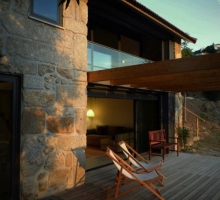The Douro Carboniferous Basin is the most extensive outcrop of the continental Carbonic existent in Portugal, going from S. Pedro Fins (E to Oporto) to Janarde (E to Arouca), along a narrow strip of about 50 km length, rarely exceeding 500 m wide. The orientation of the basin’s rocks is approximately N130°±10°E, with inclinations almost always to NE and varying from 45° to 90°. In this geosite, it is possible to find a clast-supported breccia-conglomerate belonging to this outcrop of the Carbonic. It is formed by elements coming from older neighbor rocks, like the schist rocks of the Dúrico-Beirão supergroup and also the quartzite probably coming from materials of the Santa Justa and Sobrido formations. The origin of this conglomerate is related to the erosion and desegregation of the slopes of the continental sedimentation basin (lake basin), in the final part of the Carbonic Period, at about 300 million years ago.
Location: Arouca
Location: Arouca




